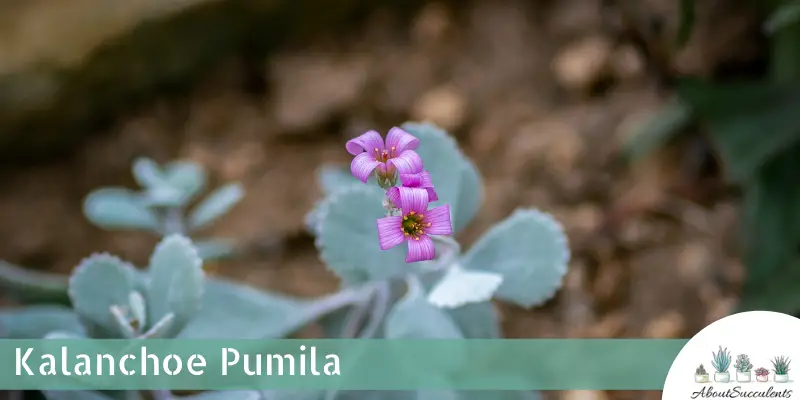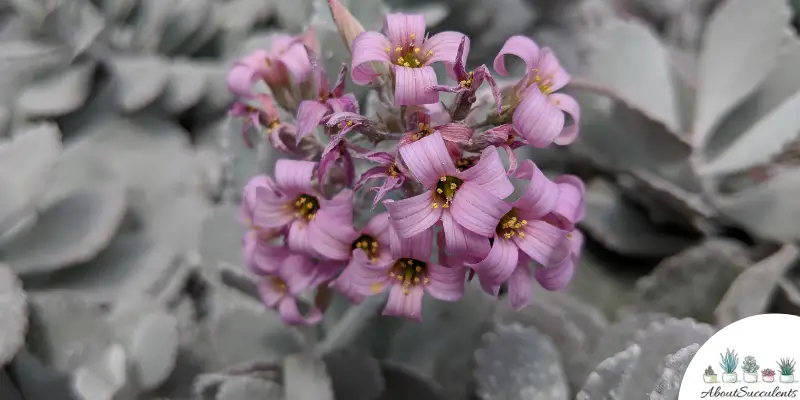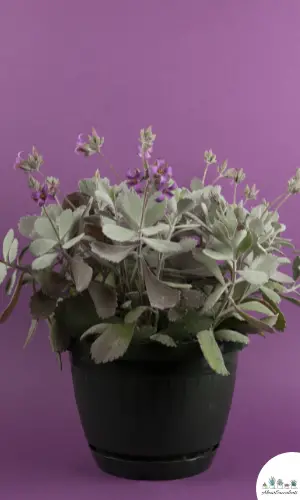
Kalanchoe Pumila is a small, spreading, succulent plant with features characterized by silver, waxy hairs that give it the appearance of a clumping, compact, and dusty bush.
The oblong leaves have wrinkles on the edges and when “Flower Dust Plant” blossoms, it produces small pink flowers with purple veins. As Kalanchoe Pumila matures, it can reach a height of 30cm or 12-inches.
Flower Dust Plant is a member of the Crassulaceae family and is native to Madagascar. A popular choice among succulent hobbyists, Kalanchoe Pumila has received the Royal Horticultural Society’s Award of Garden Merit.
General Information:
Also known as: Flower Dust Plant
Plant Family: Crassulaceae
Origin: Madagascar
Height: 30cm (12-inches)
Exposure: Full to partial sun
Water Needs: Water only when soil is dry to the touch; less watering during the cold months
Soil Type: Standard potting soil mix with the addition of pumice, compost, perlite, and sand.
Soil pH: 5.6 to 6.5
How to Grow and Care for Kalanchoe Pumila

Kalanchoe Pumila is not a cold-hardy plant. This succulent subshrub prefers climates with temperatures of -6.7 °C (20 F).
If you live in regions with lower temperatures, it would be recommended to grow Flower Dust Plant in a pot that can be transferred indoors.
You can grow Kalanchoe Pumila as a hanging succulent or as a colorful accent to a rock garden.
Sunlight
Flower Dust Plant is a type of succulent that grows better under strong light. As an outdoor succulent plant, place Kalanchoe Pumila in an area in the garden that receives 6 hours of sunlight every day.
When moving Kalanchoe Pumila indoors, position the pot in an area where the succulent plant can receive 6 hours or partial to full sunlight.
Watering
Kalanchoe Pumila has similar watering needs as other succulent plants. It’s important to remember that overwatering is not good for this type of plant. We recommend the soak and dry method as the best way to water Flower Dust Plant.
Check the moisture level of the soil before watering. You can insert a stick half an inch into the topsoil. If the end of the stick is dry to the touch then you can water the soil until it’s drenched. Wait for the soil to completely dry out before watering it again.
Watering will be less frequent during the colder months because the soil will remain moist longer.
Pot and Soil
Ceramic and terra cotta are the best materials for pots because they are breathable and allow for the proper evaporation of moisture from the soil. Make sure that the pot has a drain hole to let excess water come out of the soil.
Kalanchoe Pumila will grow best in a pot filled with a well-draining mix of soil such as a standard potting mix combined with pumice, compost, sand, and perlite. The level of drainage will improve by adding these ingredients to the soil mix. These ingredients will also prevent soil compaction. The ideal pH level for the soil is from 5.6 to 6.5.
How to Propagate Kalanchoe Pumila

Kalanchoe Pumila is popular with horticulturists because you can propagate it from stems or leaf cuttings. Your chances of successful propagation will be greater if you use cuttings from stems.
Method 1 – Stem Method
Step 1: Remove a stem by cutting it off with a sharpened and sterilized knife or pair of garden shears.
Step 2: Place the stem in a dry area.
Step 3: Wait for the stem to develop hard calluses and this should take 2 to 3 days,
Step 4: Place the stem on top of a well-draining soil mix.
Step 5: Water the soil by misting the surface whenever it has dried out completely.
Method 2 – Leaves Method
Step 1: Remove a leaf from the stem by using a sharp, sterilized knife or a pair of garden shears.
Step 2: Make sure that you perform a clean cut from the stem. If a part of the leaf remains on the stem, you won’t be assured of successful propagation.
Step 3: Allow the leaf to develop hard calluses all over by laying it in a dry area.
Step 4: When the leaf has developed calluses, place it on well-draining soil and allow the cuttings to grow roots.
Step 5: Before watering, check the moisture level of the soil. If the topsoil is dry to the touch, lightly mist it with water.
Method 3 – Repotting
Repotting Flower Dust Plant will reinvigorate the succulent and give it new growth. Kalanchoe Pumila can be repotted every 2 years.
Succulents are often planted in plastic pots that have no drainage. Repot Kalanchoe Pumila once you get home by transferring it to a ceramic or terra cotta pot that has a drain hole.
Gently remove the plant from the pot and shake off excess bits of soil. Let it dry in an area. Replace the pot with well-draining soil before transferring Kalanchoe Pumila.
Frequently Asked Questions
Is Kalanchoe Pumila Toxic for Cats and Dogs?
The website of the American Society for the Prevention of Cruelty to Animals (ASPCA) makes no mention of Kalanchoe Pumila as a succulent that’s toxic for cats and dogs.
Why is my Kalanchoe Pumila Dying?
Your Senecio serpens succulent could be dying because of 3 possible reasons: Overwatering, etiolation, and pest infestation.
There are 3 possible reasons why your Kalanchoe Pumila is dying: Overwatering, not enough sunlight, and pest infestation.
Overwatering
When it comes to Kalanchoe Pumila, underwatering is better than overwatering. Giving the succulent too much water will result in the roots rotting. Once the roots start to rot, the infection will spread quickly throughout the plant.
If you see discoloration appear on the stems and leaves of the Flower Dust Plant, remove them right away with a pair of sharp and sterilized scissors. Remove the plant from the pot, cut away the roots that have signs of rotting, and begin the process of re-potting.
Not Enough Sunlight
Etiolation might occur if the succulent doesn’t receive enough sunlight. Etiolation is the process where the leaves stretch out as if in search of sunlight. When this happens, Flower Dust Plant’s leaves thin out and become limp.
The problem can be fixed simply by exposing Kalanchoe Pumila to sunlight gradually. Start out by placing the plant in partial sunlight.
Pest Infestation
Mealybugs and aphids weaken Kalanchoe Pumila by sucking out its sap. Snails and slugs can destroy their leaves. You can wipe the leaves with 70% isopropyl alcohol or with neem oil to remove the pests.
Flower Dust Plant can also develop powdery mildew and rust-colored pustules on the leaves and stems. The primary cause of the succulent developing disease is overwatering.
Does Kalanchoe Pumila Produce Flowers?
Yes, Kalanchoe Pumila produces small pink-purple flowers in the springtime.
Last Updated on June 9, 2022 by Sofia Lara